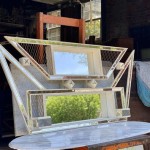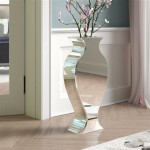How To Hang A Mirror Using Picture Wire
Hanging a heavy mirror securely requires the right hardware and technique. Picture wire offers a strong and flexible solution for heavier mirrors, distributing the weight evenly across two hanging points. This guide provides a step-by-step approach to hanging a mirror using picture wire.
1. Gathering the Necessary Tools and Materials
Before beginning the hanging process, gather the necessary tools and materials. This ensures a smooth and efficient installation. The required items include a measuring tape, a pencil, a drill with appropriately sized drill bits, two D-rings or screw eyes, picture wire rated for the weight of the mirror, two wall anchors appropriate for the wall type (e.g., drywall anchors, masonry anchors), a hammer (if necessary for the wall anchors), and a level.
Selecting the correct weight rating for the picture wire is crucial for safety. Check the packaging of the picture wire to ensure it can support the weight of the mirror. Using a wire with too low a weight rating can lead to the wire breaking and the mirror falling.
2. Installing the D-Rings or Screw Eyes
D-rings or screw eyes provide the attachment points for the picture wire. Measure and mark the desired locations for the D-rings on the back of the mirror. These should be positioned equidistant from the center of the mirror and a few inches down from the top edge. The specific placement will depend on the size and shape of the mirror. Ensure the chosen positions allow the mirror to hang level.
Once marked, use the appropriately sized drill bit to pre-drill pilot holes for the D-rings or screw eyes. This prevents the wood from splitting, particularly important with older or delicate frames. Then, securely attach the D-rings or screw eyes to the mirror frame, ensuring they are tightly fastened.
3. Attaching the Picture Wire
With the D-rings or screw eyes in place, the next step is to attach the picture wire. Cut a length of picture wire approximately twice the width of the mirror, plus an additional 12 inches. This extra length provides ample wire for wrapping and creating the necessary slack.
Thread one end of the wire through the first D-ring or screw eye. Wrap the short end of the wire around the longer length several times, creating a secure loop. Repeat this process on the other D-ring or screw eye, ensuring the wire is taut but not overly tight. There should be some slack in the wire, forming an inverted triangle shape when the mirror is lifted by the wire. The amount of slack determines how high the mirror will hang from the picture hook.
4. Locating and Installing the Wall Anchors
Before installing wall anchors, determine the desired hanging height of the mirror. Measure from the top of the mirror to the apex of the wire triangle formed when the mirror is lifted. This measurement is crucial for placing the wall anchors at the correct height.
Mark the wall where the hanging hardware (picture hooks or nails) will be placed. The distance between these marks should be slightly less than the distance between the D-rings to create the proper angle for the wire to rest on the hardware. Use a level to ensure the marks are perfectly horizontal. Depending on the wall type and the weight of the mirror, wall anchors may be necessary to provide adequate support. If using wall anchors, carefully follow the manufacturer’s instructions for installation.
5. Hanging the Mirror
Once the wall anchors are securely in place, install the picture hooks or nails. Ensure they are firmly attached and can support the weight of the mirror. Carefully lift the mirror and place the picture wire onto the picture hooks or nails.
After hanging the mirror, use a level to ensure it is perfectly straight. Adjust the wire on the hooks if necessary to achieve the desired alignment. Step back and admire the securely and beautifully hung mirror.
6. Considerations for Different Wall Types
Different wall types require different hanging hardware. Drywall typically requires drywall anchors for heavier objects like mirrors. For plaster walls, it is often possible to use a standard picture hook or nail, but for heavier mirrors, wall anchors specifically designed for plaster are recommended. For brick or concrete walls, masonry anchors are necessary. Always choose anchors rated for the weight of the mirror.
Understanding the specific needs of each wall type will ensure the mirror is hung securely and prevent damage to the wall.

How To Hang A Mirror With Wire Pictures Wikihow

How To Adjust A Mirror Art Or Picture Hanging Wire

How To Adjust A Mirror Art Or Picture Hanging Wire

How To Hang A Mirror With Wire Pictures Wikihow

How To Hang A Mirror Home
How To Hang A 100 Pound Mirror On Drywall Quora

Picture Wire Strung Between Two D Rings Attached To The Back Of A Frame Hanging Mirror Heavy

How To Hang A Mirror With Wire Pictures Wikihow

How To Adjust A Mirror Art Or Picture Hanging Wire

How To Hang A Heavy Mirror With Pictures Wikihow








